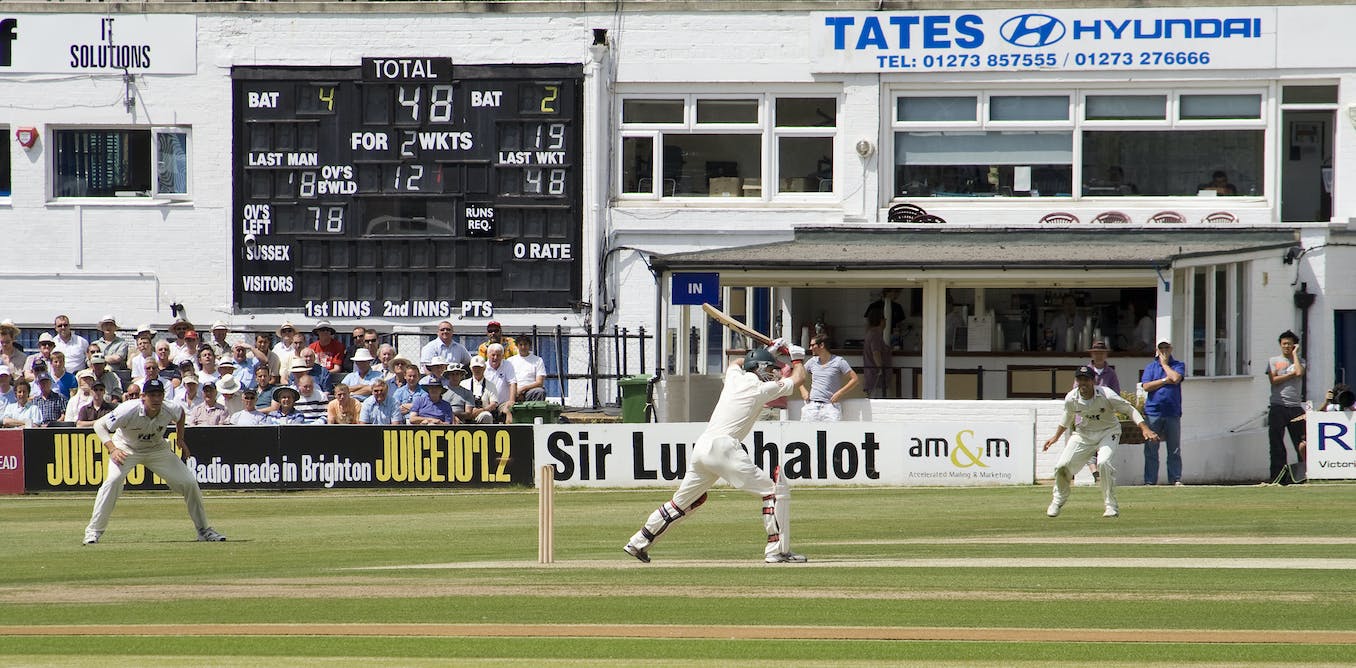Bowlers playing for England and Australia in the current Ashes cricket series are collectively meant to deliver at least 540 balls each day (that’s 90 overs of six balls each – more if they bowl any no-balls or wides). If one side’s bowlers cannot capture all ten wickets in one day, they must toil on into the next.
Each of the five Test matches in the men’s series, and one in the women’s, last for a maximum of five days. To win, bowlers usually need to get the other side all-out twice. Australia’s men’s team won their first Ashes Test with only minutes to go in the final session of the fifth day.
In many ways, this biennial series feels a battle against time itself. Unlike most other sports such as football, whose matches are over in a short, set period of time, Test cricket represents abstract, long-term, targeted behaviour – something that people actually do on a daily basis. In this sense, the players in this Ashes series can teach us something about how the mind responds to time – and how this is linked to reward, threat and anxiety.
Just like these Test cricketers are focused on winning a series weeks in the future, our day-to-day functioning is governed by the larger projects that we are aiming for – be that career goals or family bliss. To reach these overarching goals, we must experience short periods of extreme pressure and anxiety. It is time, combined with an uncertain outcome, that leads us to experience this anxiety.
Think, for example, of an upcoming exam period which you don’t know whether you’ll excel at. Or when your future goal of love hinges on what will happen tomorrow when you ask out your crush. How we deal with such anxiety, which comes about partly because of the short timeframe of these key moments, can be of huge importance to our quality of life.
The ABC of time
Research in psychology has shown that anxiety for humans comes in the form of negative, uncontrollable thoughts – a racing heartbeat, heavy shallow breathing, uneasiness and a sense of panic.
This is followed by our attention being snatched from us to focus on a real or imagined threat. In cognitive behavioural therapy, this is captured in the alarm-beliefs-coping model of anxiety (ABC).
This model can be easily understood through cricket. When the batter waits for the bowler, they are in a state of alarm (A). Their beliefs (B) about whether the upcoming ball is a threat or not lead to an initial anxiety wave. Then they have to use coping (C) resources to combat this and (hopefully) maintain their stability of mind.
A similar process happens when we get anxious about an examination. If our belief is that we are underprepared, we experience a rise in anxiety. We then have to engage with our coping resources – be they a study plan or optimistic thinking – to manage these uncontrollable thoughts.
This may seem simple, but between A, B and C, our perception of time changes. Research indicates that when individuals experience anxiety, their perception of time elongates – so this period feels like it is going on much longer than it actually is. That means it can have a huge effect on us, eventually affecting our sleep, diet and emotional stability.
Research has found that each ABC process literally activates a different part of the brain. To put it simply, during anxiety, our brain switches into an emergency threat mode, and the neural circuits in our brain react differently.
A cricket batter is constantly forced to experience high anxiety before each delivery is bowled. And unless they are out, they then have to manage it again, and again – each time, another uncertain outcome. To score a century, a batter in Test cricket might typically face between 80 and 150 deliveries (though the world record is only 54). So, how do the world’s best performers manage this – and what can they teach us?
Taking control of time
Sport and performance psychologists often work with high performers to build their resilience to anxiety via “cognitive reattribution training” (CRT). Although the specific strategy used varies, the principle remains the same – perceiving the situation as a whole rather than an isolated part.
Ollyy/Shutterstock
This involves moving beyond thinking everything hinges on one moment. By doing this, the alarm response subsides, and the uncertain moments causing anxiety feel shorter and therefore cause less damage.
We also try to help the athlete cope by figuring out what level of control they have over various actions. Bowlers, for example, only have control until they release the ball. After that, there’s no point in fretting about the direction of the ball.
Batters, meanwhile, have very little control since they have to react to the bowling, ball by ball. If the athlete has an illusion of control, it leads to errors. The focus of attention should be on the elements they can control, such as the target point. They should withdraw focus from elements they can’t control.
We can all learn from this. Take an example from daily life: you need milk. You run to the grocery store but they have run out. You have zero control over this, and now have an uncertain outcome of where to get milk for your morning coffee. CRT allows us to isolate what can we control.
A CRT-based thought pattern would be: “I can control the fact that I need milk (X), but I cannot control the shop’s milk stock (Y)”. This allows you to refocus mental resources to allocate 80% of your attention and effort into finding other sources of milk, such as going to another shop or asking your neighbour. This is much better than hyperfocusing on the scenario you cannot control, arguing with the shop’s manager, getting angry and so forth.
Of course, many situations in life are much more complicated than this. The most helpful process here is accepting that you only have some control, then using CRT to allocate efforts accordingly. CRT ultimately allows the individual to break down a stream of thoughts into areas of what we can control from 0 to 100%. Think of it as a sorting process.
A Test match’s beauty is that it feels almost indefinite in time. Much like life, all four results are on the table: win, loss, draw and even a tie. The trick is to understand our ABCs and, by doing that, manage how our mind reacts to time.



